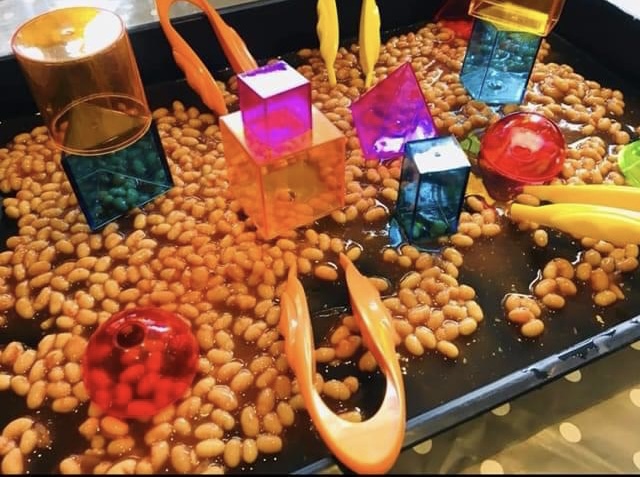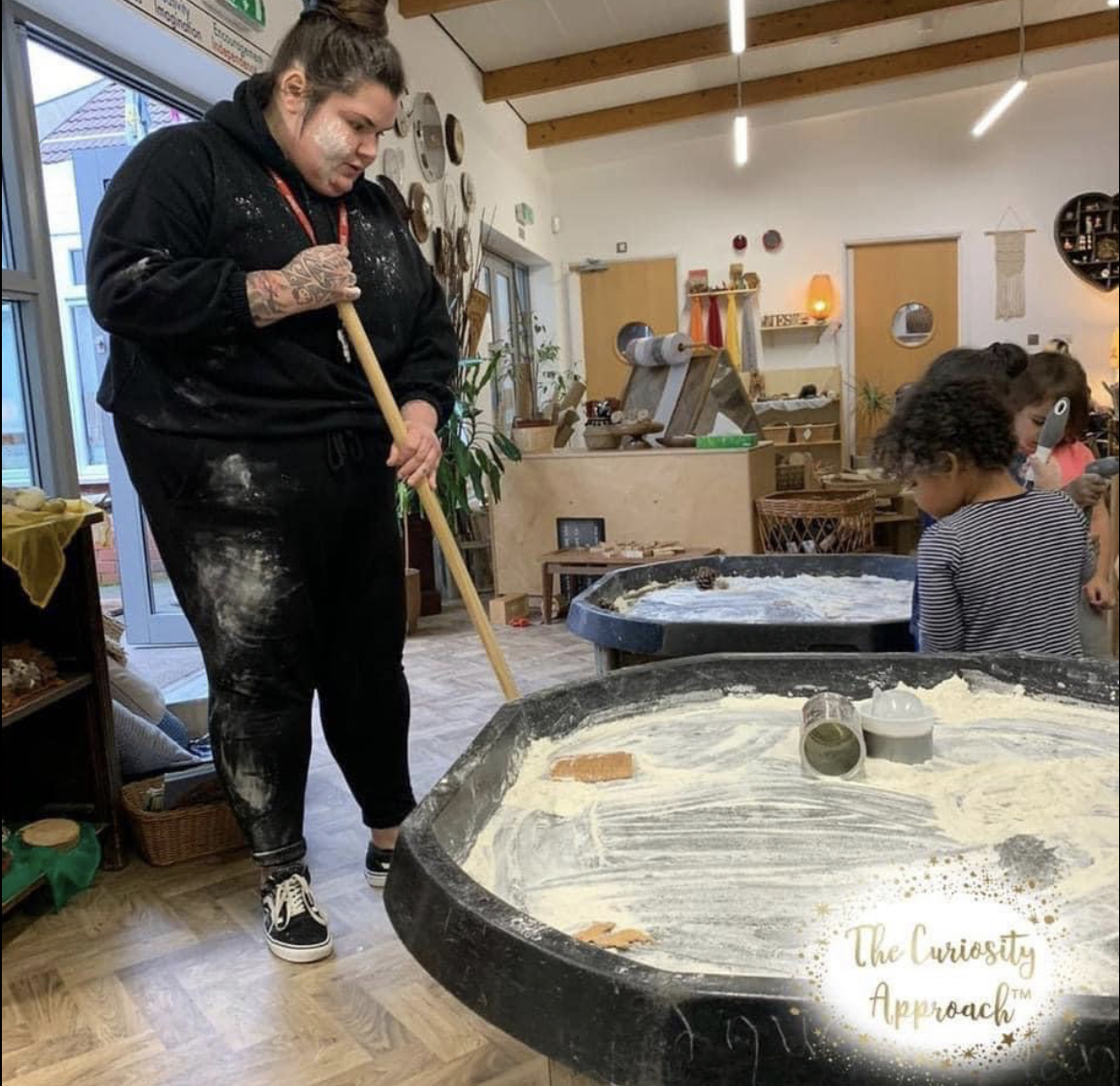Rethinking food in Tuff trays.
Release Date: July 31, 2023
Last Updated: October 27, 2023
At The Curiosity Approach® we are advocates for the expansion of sensory play experiences beyond traditional food-based tactile interactions. While activities involving cooked spaghetti, baked beans, and jelly have long been popular in early childhood education, we believe that incorporating loose parts and natural resources into tuff trays can provide a more sustainable and inclusive approach to messy play.
In this blog, we will explore the reasons behind this shift, considering the issues of food waste, food poverty, and the importance of promoting alternatives that benefit both children and the environment.
Food Waste and Environmental Impact:
Using food as a sensory material in tuff trays often leads to significant amounts of waste. The disposal of uneaten or contaminated food can contribute to the growing problem of food waste, exacerbating the strain on landfills and the environment. According to the Food and Agriculture organisation, approximately one-third of the world's food production is wasted each year. By opting for loose parts and natural resources, we can reduce this waste and promote a more sustainable approach to early childhood education.

Food Poverty and Inequality:
In the United Kingdom, food poverty remains a pressing issue, affecting many households and young children. The Trussell Trust, a prominent UK charity, provides food banks and support to individuals and families experiencing food insecurity. Statistics from the Trussell Trust reveal that in the year 2020-2021, they distributed 2.5 million emergency food parcels to people in crisis, with over 980,000 of those going to children. This alarming data highlights the need for a sensitive approach to messy play that does not exacerbate food poverty or inadvertently perpetuate inequalities.
Promoting Inclusivity and Sensory Exploration:
By embracing loose parts and natural resources in tuff trays, educators can foster a more inclusive and accessible environment for all children. While food-based sensory play experiences can exclude children with dietary restrictions or allergies, incorporating items such as water, sand, dirt, clay and heuristic play allows for a broader range of sensory exploration for all children including those children with additional needs an SEND. This approach ensures that all children can engage in tuff tray experiences and benefit from the developmental opportunities it offers.
Research Supporting Alternative Approaches:
Research supports the notion that sensory play involving loose parts and natural resources contributes to children's holistic development. According to a study by Gray and Brown (2018), sensory play experiences that involve manipulating natural materials can enhance cognitive, physical, and social-emotional skills. Furthermore, other studies have shown that engaging with nature and loose parts stimulates creativity, problem-solving abilities, and overall well-being in children.
Rethinking the Traditional Approach:
To shift towards a more sustainable and inclusive approach to messy play, educators and parents can start by rethinking the materials used in tuff trays. Instead of relying solely on food, they can consider incorporating loose parts such as pinecones, seashells, pebbles, fabric scraps, and wooden blocks. Natural resources like water, sand, dirt, and clay offer endless opportunities for sensory exploration and creative expression.
Furthermore, it is crucial to emphasise that the focus of messy play should not solely be on creating aesthetically pleasing designs within the tuff trays. While visually appealing setups may initially capture attention, the true value lies in observing and supporting children's individual learning styles, particularly their schematic learning styles.
Let’s rethink
Schematic learning refers to the patterns of repeated behaviours, interests, and play preferences that children exhibit as they explore and make sense of the world around them. These schemas, as identified by Chris Atley and psychologist Jean Piaget, reflect a child's cognitive development and provide insight into their unique ways of thinking and understanding their environment.
By incorporating loose parts and natural resources into tuff trays, educators can encourage children to engage with materials in ways that align with their specific schemas or as we like to describe them as ‘urges’. For example, a child exhibiting a transporting schema might enjoy moving and transferring materials from one container to another using natural resources like pebbles or fabric scraps. Another child with a trajectory schema might be fascinated by pouring water down different surfaces, exploring the concepts of gravity and motion. We like to watch what children are ‘doing’ in play instead of focusing on the design or set up of the tray itself.
By observing and understanding children's schematic learning styles, educators can tailor their play experiences to promote deeper engagement and learning. This approach shifts the focus from a predetermined outcome or a picture-perfect tray to providing open-ended opportunities for children to explore, experiment, and express their ideas and theories through play.
Incorporating loose parts and natural resources not only supports children's schematic learning but also nurtures their creativity, problem-solving abilities, and critical thinking skills. Unlike food-based materials that have limited possibilities, loose parts offer endless opportunities for manipulation, construction, and imaginative play. Children can utilise natural resources to build structures, create sensory landscapes, or engage in role-playing scenarios, fostering their cognitive, social, and emotional development.
Moreover, by prioritising children's exploration and observation, educators can encourage them to become active participants in their own learning journey. They can facilitate discussions, ask open-ended questions, ( at the appropriate time) and scaffold children's thinking processes as they interact with the materials. This approach fosters a sense of curiosity, independence, and confidence, empowering children to take ownership of their learning experiences. Let’s remember babies are born primed to receive and respond to stimuli and it is not dependent on whether we provide cooked spaghetti in which they can play.
In conclusion, the true essence of a ‘tuff tray’ lies not in the visual appeal, but rather in the meaningful interactions and observations that occur during the process.
By embracing loose parts and natural resources, educators can create rich and inclusive learning environments that support children's individual learning styles and promote their holistic development. Through sensory exploration and engagement with diverse materials, children can express their schemas, ignite their creativity, and develop essential skills that will serve them well beyond their early years. Let us celebrate the joy of play as a dynamic and child-centered experience that fosters lifelong learning.
Conclusion:
As advocates of sensory play, the Curiosity Approach® encourages early childhood followers to reconsider the use of excessive food in tuff trays. By embracing loose parts and natural resources, educators can reduce food waste, contribute to the fight against food poverty, and create more inclusive learning environments. Sensory exploration with diverse materials not only supports children's development but also fosters a deeper connection with the natural world.
Let us embrace this shift at The Curiosity Approach® we recognise that many will disagree with our thoughts and today our aim is to respectful act as a critical friend. Opening up our perspective and sharing our thoughts.
Food play isn’t all black and white either is it?
It’s a subject that offers opportunity for much discussion and differing opinions. Also where do we draw the line? Play dough can also be seen as a food. Flour, cornflour are all ingredients that can be determined as food play?

At The Curiosity Approach® we still use play dough and even feel inclined to rescue those wrinkly apples before they go in the bin and may offer these in play. Contradicting ourselves ?
Maybe ? Isn’t it all food for thought ( pardon the pun) shouldn’t we all know WHY we do certain things and how we can look to prevent food wastage. Saving food, growing food? Knowing our own WHY
Want to know more? Let us explain in our Team gathering with is all about tuff Trays and what to use instead of food. Curious ? See the link below and we hope we can clarify further. https://the-curiosity-approach...
References - The Trussell Trust is a UK charity that provides food banks and support to individuals and families experiencing food insecurity. You can find statistics and reports on food poverty and food insecurity on their official website: https://www.trusselltrust.org/
C., & Brown, D. (2018). Play in the early years: A critical study of the learning environment. Routledge.
Piaget, J. (1952). The origins of intelligence in children. International Universities Press.
This blog is the intellectual property of The Curiosity Approach® and protected by copyright
Take the score card quiz here https://thecuriosityapproach.s...


